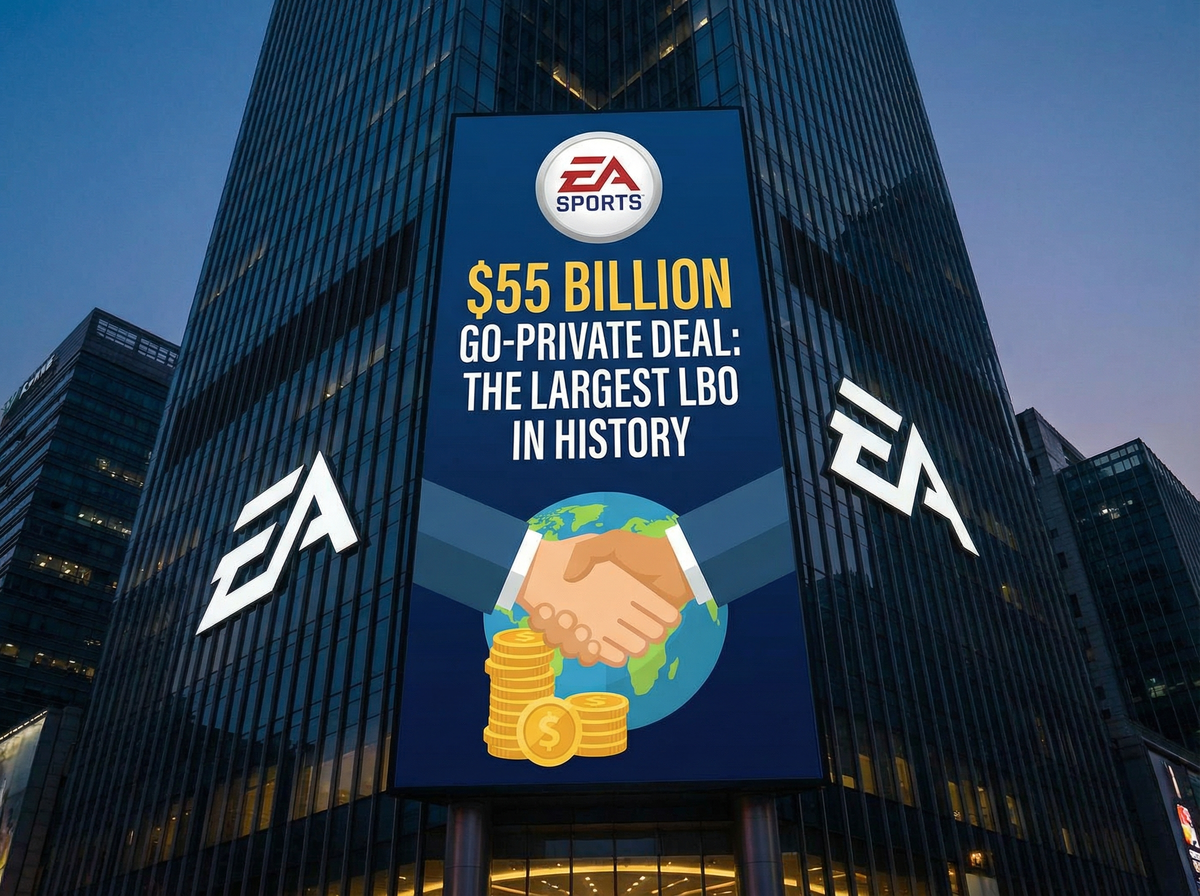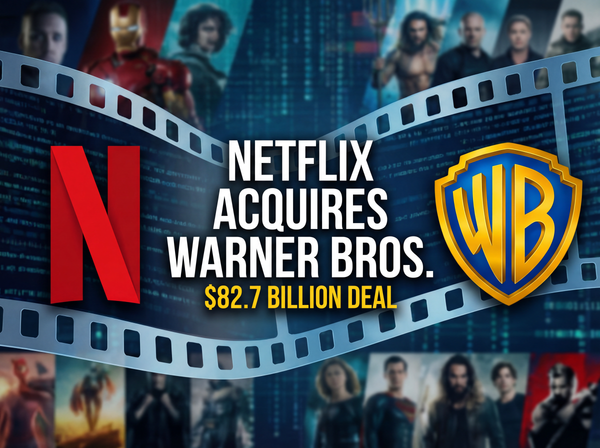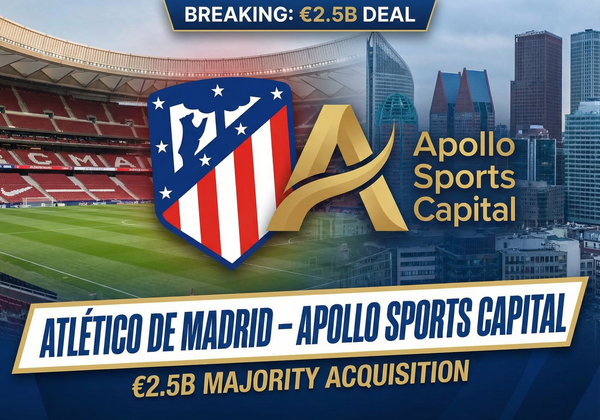Electronic Arts’ $55B Go-Private Deal: The Largest LBO in History

TL;DR (Key Takeaways)
- Deal Size: $55B enterprise value – the largest leveraged buyout (LBO) in history.
- Buyers: Saudi Arabia’s Public Investment Fund (PIF) (majority stake), Silver Lake, and Affinity Partners.
- Financing: ~$36B equity + $20B debt (underwritten by JPMorgan).
- Valuation: $210/share cash offer, ~25% premium to pre-rumor price.
- Timeline: Expected close by mid-2026 pending shareholder & regulatory approvals.
- Revenue Mix: ~70% from live services (Ultimate Team, EA Play), ~20% from full game sales, remainder from mobile & licensing.
- Business Strength: Moat in sports licensing, sticky live-service revenues, diversified IP portfolio.
- Growth Drivers: New IP, mobile expansion, esports, and global markets (esp. Middle East & Asia).
- Industry Outlook: Gaming remains a $200B+ global market, growing 7–8% annually, attractive for mega-cap private equity deals.
Executive Summary
In September 2025, Electronic Arts agreed to be acquired and taken private by a consortium led by Saudi Arabia’s PIF, alongside Silver Lake and Affinity Partners, for $210 in cash per share.
The deal values EA at roughly $52.5B equity and ~$55B enterprise value — a record-setting all-cash take-private and the largest LBO ever.
The consortium highlights gaming’s durable cash flows, EA’s sports and live-service franchises (EA Sports FC, Madden, Apex Legends, The Sims, Battlefield), and the opportunity to invest off-market without quarterly scrutiny. EA’s management remains, led by CEO Andrew Wilson.
Deal Terms & Valuation
Headline consideration
- Price: $210.00 per share (all cash)
- Premium: ~25% to the pre-rumor close (~$168) and above EA’s prior ATH (~$179)
Implied valuation
- Equity value: ~$52.5B
- Enterprise value (EV): ~$55B (includes modest net debt)
Multiple context
- Implied EV/EBITDA ~19–20× (based on ~$2.8–3.0B est. EBITDA)
- Among the highest multiples paid for a large gaming publisher; second only to Microsoft–Activision in deal size for the sector.
Consortium
- Public Investment Fund (PIF): Lead investor; rolling ~9.9% stake and adding significant new equity.
- Silver Lake: Tech-focused PE firm (history with Dell take-private).
- Affinity Partners: Investment firm founded by Jared Kushner.
Timeline & Closing Conditions
- Signing: Late September 2025 (Board unanimously approved).
- Shareholder vote: Expected in the months after signing.
- Anticipated close: Q1 FY2027 (roughly April–June 2026), subject to shareholder and regulatory approvals.
- Break fees:
- EA termination fee: $1B (e.g., superior offer).
- Reverse break fee: $1B (e.g., regulatory failure/long delay).
- Post-close: Shares delisted; EA operates privately.
Financing Structure (Equity & Debt)
Equity (~$36B total)
- PIF: Largest equity check; includes rollover of its ~9.9% stake.
- Silver Lake & Affinity: Significant cash equity from existing funds/mandates.
Debt (~$20B)
- Underwriter: JPMorgan (fully committed).
- Draw: $18B at close + $2B delayed/revolver (expected).
- Pro forma leverage: ~6.5×–7.0× Debt/EBITDA (depending on final EBITDA).
- Interest sensitivity: High-single-digit yields imply ~$1.4B+ annual interest at $18B funded; equity-heavy mix helps cushion risk.
Why notable: A sovereign-anchored, equity-forward structure at record scale; single-bank underwriting signals confidence and financing certainty.
EA’s Current Revenue Streams (FY2025 Snapshot)
Electronic Arts generates ~$7.4–7.8B in annual revenue across four main categories:
- Live Services & Other (≈70%)
- Includes Ultimate Team modes, microtransactions, subscriptions (EA Play), and other in-game monetization.
- This segment has become EA’s largest growth engine, contributing over two-thirds of total revenue.
- Full Game Sales (≈20%)
- Traditional packaged and digital downloads of AAA titles like Battlefield, The Sims, and EA Sports FC.
- Declining share of mix as players shift toward ongoing engagement models.
- Mobile Gaming (≈7–8%)
- Driven by titles from Glu Mobile (acquired 2021) and Scopely JV, spanning casual and mid-core games.
- Other (≈2–3%)
- Licensing, merchandising, and smaller revenue streams from third-party publishing.
Key takeaway: EA’s recurring live-service revenue base (especially Ultimate Team) makes its cash flow highly predictable — a central reason it was attractive for an LBO.
Industry Attractiveness: Why Gaming Remains a Prime LBO Target
Despite post-pandemic volatility, the global video game industry continues to show strong fundamentals:
- Scale & Growth: Global gaming market estimated at >$200B in 2025, projected to grow 7–8% CAGR through 2030.
- Resilient Demand: Games remain a counter-cyclical entertainment form — even during downturns, engagement and spending stay strong relative to film/TV.
- Shift to Digital & Recurring Revenues: Expansion of live services, in-game purchases, and subscriptions makes revenues more predictable (attractive for leveraged finance).
- Globalization of Gaming: Markets like the Middle East, India, and Latin America are growing rapidly, providing new opportunities for scaled publishers like EA.
- Consolidation Wave: With Microsoft–Activision, Take-Two–Zynga, and now EA’s LBO, the industry is consolidating — making standalone AAA publishers rarer and more valuable.
Investor lens: Few industries combine recurring revenue, global scale, strong IP, and cultural relevance as powerfully as gaming.
Strategic Rationale (Buyers & EA)
Why the buyers want EA
- Long-term gaming growth: Sticky IP, live services, annualized sports titles, and robust recurring revenue.
- Soft power & culture: For PIF, gaming sits alongside sports/entertainment in a broader cultural influence strategy.
- Financial profile: High-margin digital revenue + strong cash flow characteristics fit LBO playbooks.
- Private roadmap: Freedom to invest counter-cyclically (new IP, M&A, tech) without quarterly EPS constraints.
Why EA said yes
- Compelling certainty of value: $210 cash exceeds pre-rumor levels and prior ATH.
- Industry dynamics: Rising AAA costs, hit-risk, creator-economy competition, and consolidation tilt the field toward scale.
- Capital & time: Private ownership supports bigger bets (pipeline, platform, tech like cloud/AI/VR) with patient capital.
- Strategic networks: PIF/Silver Lake/Affinity bring access to sports, media, and regional markets.
Potential Growth Drivers Under Private Ownership
The investor consortium is expected to double down on EA’s strengths while exploring new growth frontiers. Key areas to watch:
- Sports Franchise Expansion
- EA Sports FC (ex-FIFA) and Madden NFL remain tentpole franchises.
- Potential tie-ins with Saudi-backed sports properties (e.g., esports events, Middle East tournaments).
- New IP Development
- Freed from quarterly pressures, EA could fund riskier new franchises or revive dormant IP (e.g., Dead Space, Command & Conquer).
- Mergers & Acquisitions
- With fresh capital, EA may pursue studio acquisitions in emerging genres (e.g., mobile, survival, creator-driven games).
- Global Market Expansion
- Middle East & Asia are major untapped opportunities. PIF’s network may help EA localize and distribute more aggressively.
- Emerging Technology Plays
- Investment in cloud gaming, VR/AR, and possibly AI-driven game development could enhance productivity and player experiences.
- Direct-to-Consumer Monetization
- Growth of EA Play subscriptions, potential premium tiers, and deeper integration into third-party platforms like Xbox Game Pass.
Bottom line: If executed well, EA’s growth under private ownership could hinge on sports + live services + global expansion, with optional upside from M&A and tech bets.
The Role of AI in Gaming’s Future
Artificial intelligence is set to become one of the biggest value drivers in the gaming industry over the next decade — and for Electronic Arts under private ownership, it represents both a cost efficiency lever and a creative frontier.
1. Smarter Game Design & Development
- Procedural content generation: AI can create dynamic environments, characters, and storylines — reducing production time and cost for AAA games.
- Testing automation: AI-driven QA tools can identify bugs, optimize gameplay balance, and accelerate release cycles.
- Adaptive difficulty & personalization: Machine learning can tailor difficulty and missions to player behavior, improving engagement and retention.
2. Player Experience Enhancement
- AI NPCs (non-player characters): Next-gen AI models allow NPCs to interact with players in natural language — potentially creating more immersive, story-driven games.
- Voice and animation synthesis: Generative AI can produce realistic voiceovers and facial animations without the need for full mocap studios.
3. Business & Monetization Impact
- Predictive analytics: AI can forecast player churn, inform monetization strategies, and optimize in-game economies.
- Content moderation & community management: Automated systems can filter toxicity, keeping multiplayer communities healthier.
For EA:
With major franchises like The Sims, FIFA/EA Sports FC, and Battlefield, AI could enable richer simulation, dynamic storylines, and cost-efficient live-service operations.
The new owners (Silver Lake, PIF, Affinity) may see AI as a profitability multiplier — blending creative potential with operational savings.
Regulatory & Political Review
- Antitrust: Low concern — financial buyers (not horizontal competitors); no direct reduction in industry competition.
- CFIUS/foreign investment: Possible review given foreign sovereign control and EA’s user data footprint; mitigations may include data localization/governance covenants.
- EU/UK/other jurisdictions: Expected routine competition reviews; foreign subsidies scrutiny is possible but unlikely to be blocking.
- Optics: Potential public/political scrutiny around PIF ownership; unlikely to form a legal barrier absent security issues.
Governance & Operating Plan Post-Close
- Leadership: Andrew Wilson remains CEO; continuity with existing studio leadership expected.
- Board: Reconstituted to represent owners (PIF / Silver Lake / Affinity).
- HQ: Redwood City, CA.
- Operating posture:
- Focus on growth, not slash-and-burn. EA’s margins are already strong; expect targeted optimization vs. wholesale cuts.
- Investment themes: Quality for flagship franchises; new IP bets; selective M&A; expansion in Middle East/Asia; sports & media partnerships leveraging owners’ ecosystems.
- Talent & incentives: Retention programs and management equity likely to align teams with private-company goals.
Benchmarks & Comparables
- Largest LBO ever: Surpasses TXU (2007) on headline EV.
- Tech/media take-privates: Larger than Twitter (2022) and Dell (2013) in nominal value; structure is more equity-heavy than pre-2008 LBOs.
- Sector precedent: Second only to Microsoft’s $69B Activision (strategic, not LBO) in gaming deal scale; underlines premium for top-tier IP.
Market Reception
- Share price: Spiked on media reports and formal announcement, trading near (but below) $210 to reflect time-to-close and residual risk.
- Analyst split:
- Pro: Certainty of value; private capital to fund long-term roadmap.
- Skeptical: Some argue $210 undervalues EA’s multi-year pipeline potential — but absence of a topping bid (so far) suggests consortium is the natural buyer.
- Credit lens: Syndication appetite for a marquee $20B package will be a bellwether for large LBO financing in a higher-rate regime.
Implications for Private Equity & Gaming
- SWFs as kingmakers: Sovereign wealth funds now co-lead mega-LBOs, reshaping competitive dynamics for traditional PE.
- Mega-LBOs return: Equity-forward structures can clear $50B+ deals even with pricier debt.
- Consolidation pressure: Fewer independent AAA publishers; attention shifts to Take-Two, Ubisoft, and regionals.
- PE in creative industries: EA will test whether PE stewardship can fuel innovation without eroding quality/community trust.
- Transmedia convergence: Expect deeper ties among games, sports, and live events (owners’ ecosystems are an accelerant).
- Openness vs. opacity: Private EA means less disclosure; competitors/partners lose quarterly visibility into performance.
Risks, Sensitivities & Scenarios
Execution risks
- Title risk: A couple of underperforming AAA launches could pressure cash flow under higher interest expense.
- Regulatory drag: Extended CFIUS or foreign reviews could push timing, risking financing costs or covenant deadlines.
- Cultural fit: Developer morale and community perception under PE/SWF ownership must be actively managed.
Financial sensitivities
- Leverage: At ~6.5–7.0×, EA needs consistent live-service bookings and sports annuals to comfortably cover $1.4B+ annual interest.
- Rates/credit markets: A slower-than-expected rate decline could affect refi or debt syndication economics.
Scenario sketch
- Base case: Steady live-service + strong sports cadence; modest margin lift; deleveraging via cash flow; potential re-IPO 3–5 years post-close.
- Upside: Breakout franchise cycle + accretive M&A; valuation rerate upon exit.
- Downside: Pipeline slippage and gamer backlash; deleveraging slows; need for equity cure or asset sales.
What to Watch Next
- Regulatory milestones: HSR/FTC-DOJ, CFIUS, EU/UK filings and timelines.
- Debt market color: Structure and pricing of term loans / HY bonds; syndication progress.
- Shareholder vote date and any activist noise on pricing.
- Operational signals: Roadmap clarity for Battlefield, EA Sports FC, Apex Legends, and The Sims; any studio acquisitions.
- Governance details: Final board composition, data-governance commitments, and employee retention packages.
FAQs: EA LBO
Q: Is this truly the largest LBO ever?
A: On headline EV (≈ $55B), yes — it surpasses TXU’s 2007 record.
Q: Why keep Andrew Wilson as CEO?
A: Continuity. The buyers are backing EA’s existing strategy and leadership to protect franchise quality and live-service momentum.
Q: Will antitrust block the deal?
A: Unlikely. Financial sponsors don’t compete directly with EA; traditional market-share concerns aren’t triggered.
Q: Could another bidder emerge?
A: Possible but improbable given the size/complexity and the consortium’s financing certainty. The $1B termination fee is not prohibitive if a clearly higher offer appears, but no rival has surfaced publicly.
Q: What changes for gamers?
A: Near-term, business as usual. The real test is whether private ownership improves quality and cadence without pushing overly aggressive monetization.


